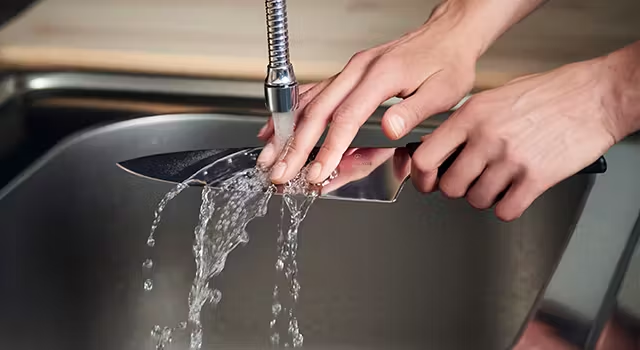A great Japanese knife can elevate your cooking — but without proper care, even the sharpest blade will lose its edge. Unlike most Western knives, Japanese chef knives are made from harder, thinner steel, which makes them sharper but more delicate.
In this beginner’s guide, you’ll learn how to clean, store, and maintain your Japanese knife so it stays razor-sharp for years to come.

1. Cleaning Your Knife After Every Use
Japanese knives should never go in the dishwasher. The heat, moisture, and harsh detergents can ruin the blade and handle.
✅ Do this instead:
- Rinse with warm water immediately after use
- Use a mild soap and a soft sponge
- Dry it immediately with a clean towel to prevent rust
💡 Tip: If you’re cutting acidic foods like tomatoes or citrus, wipe the blade during use to prevent staining.

2. Use the Right Cutting Board
Not all cutting boards are knife-friendly.
Avoid:
- Glass
- Stone
- Hard bamboo
✅ Use instead:
- End-grain wood boards (like hinoki or walnut)
- Soft plastic boards designed for professional kitchens
Using the wrong surface can dull or chip your blade.

3. Hone Your Knife Regularly
Many beginners confuse honing with sharpening — they’re not the same.
- Honing realigns the edge of the blade
- Sharpening actually removes metal to form a new edge
📅 Hone your knife every 1–2 weeks using a ceramic rod
🛠 Sharpen your knife only when needed (every 3–6 months)
If you’re new, consider using a professional sharpening service once or twice a year.

4. Store Your Knife Safely
Never toss a Japanese knife into a drawer! It’s unsafe and damages the blade.
✅ Best storage methods:
- Magnetic knife strip
- Knife block
- Blade guard / saya sheath
- Drawer organizer with slots
Keeping the blade protected will preserve its sharpness and prevent accidents.

5. Watch for Signs It Needs Sharpening
Your knife might be beautiful, but even the best blades go dull with time.
🔍 Signs to look out for:
- It slides off tomatoes or onions
- It tears rather than slices
- You need extra force to cut through soft foods
When this happens, it’s time to sharpen — or take it to a pro.
6. Bonus Tools for Knife Maintenance
Here are a few accessories that will help keep your knife in perfect shape:
🧰 Essential Tools:
- Ceramic honing rod – gentle and perfect for Japanese steel
- Whetstone (1000/6000 grit) – for sharpening when you’re ready
- Blade oil – prevents rust on high-carbon knives
(Tip: I’ll cover how to use a whetstone in a future guide!)
Conclusion
Taking care of your Japanese chef knife doesn’t have to be complicated — just clean it, hone it, store it right, and treat it with respect.
🧼 With just a few habits, your knife can stay sharp and elegant for years.
👉 Check out my Best Japanese Chef Knives for Beginners if you’re still choosing the right blade!
